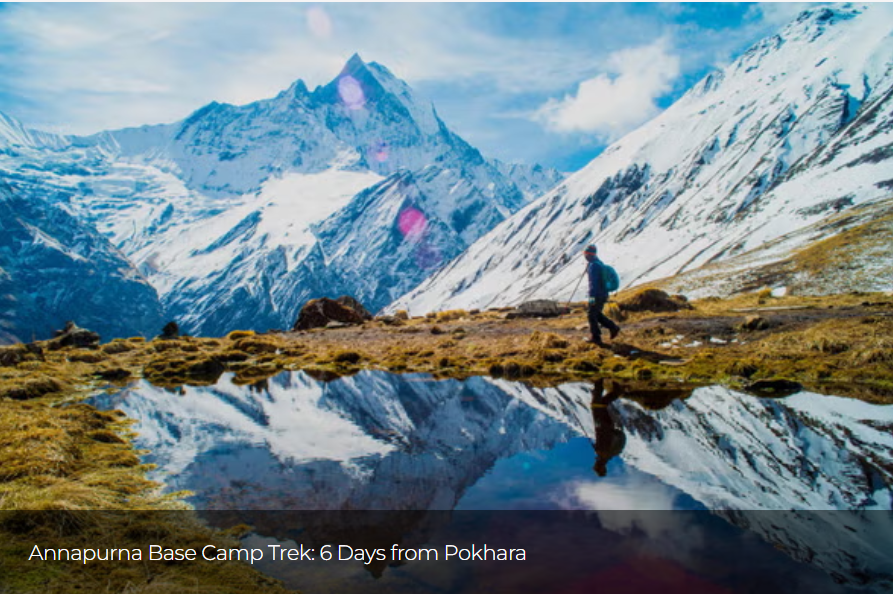Annapurna Base Camp Stunning Views
The Annapurna Base Camp trek is celebrated for its breathtaking and diverse array of stunning views that captivate trekkers at every turn. As the trek unfolds, the journey offers a panoramic spectacle of some of the most iconic and majestic peaks in the Himalayas, each contributing to the trek’s grandeur and allure.
The adventure begins with the gradual ascent through lush green forests and terraced fields, where the initial views of the surrounding hills and valleys hint at the grandeur to come. The trail meanders through charming villages, each offering picturesque glimpses of the distant snow-capped peaks. As trekkers gain elevation, the landscape transforms dramatically, showcasing the changing flora and the increasing prominence of the high mountains.
One of the most memorable highlights of the trek is the sunrise view from Poon Hill, situated at 3,210 meters. From this vantage point, trekkers witness a breathtaking panorama of the Annapurna and Dhaulagiri ranges bathed in the golden hues of dawn. The early morning light illuminates the peaks, creating a dramatic contrast with the deep blue sky, and providing a preview of the splendor that awaits further along the trail.
As the trek continues, the views evolve with each step. Passing through the dense rhododendron forests, trekkers are treated to glimpses of the towering Annapurna and Machapuchare peaks. The approach to Annapurna Base Camp Hiking offers an awe-inspiring experience as the trekker enters the Annapurna Sanctuary, a natural amphitheater surrounded by some of the highest peaks in the region. Standing at 4,130 meters, Annapurna Base Camp itself provides a 360-degree view of the Annapurna massif, including Annapurna I, Annapurna South, and the iconic Machapuchare, often referred to as the “Fish Tail” due to its distinctive shape. The sheer scale and beauty of these towering peaks, combined with the serene high-altitude environment, create a majestic and humbling sight.
The descent from the base camp allows trekkers to experience the changing perspectives of the landscape, with each viewpoint offering new and spectacular views of the mountains. The trek’s scenic splendor is not limited to the high altitudes; the journey through the varied ecosystems, from subtropical forests to alpine meadows, provides a rich visual tapestry that complements the awe-inspiring mountain vistas.
In essence, the Annapurna Base Camp trek is a feast for the eyes, offering a diverse range of stunning views that showcase the raw beauty and grandeur of the Himalayas. Each stage of the trek reveals a new facet of the landscape, making the journey a continuous celebration of nature’s splendor and a deeply rewarding experience for all who undertake it.
Introduction to the Scenic Beauty
The Annapurna Base Camp trek is renowned for its breathtaking scenic beauty, offering trekkers an immersive experience in one of the most picturesque regions of the Himalayas. From the moment you set foot on the trail, you are greeted by a landscape that changes dramatically with each passing day. The trek introduces you to a diverse array of environments, from lush subtropical forests and terraced fields to high-altitude alpine meadows and rugged mountain terrain. Each stage of the trek unveils new vistas, providing a continuous visual feast that captures the grandeur and diversity of the region. The interplay of light and shadow, the changing flora, and the dramatic shifts in elevation all contribute to the trek’s visual allure. The experience is not merely about reaching the destination but about savoring the stunning panoramas and natural beauty encountered along the way. As you ascend towards Annapurna Base Camp, the landscape unfolds in ever more spectacular ways, making the trek a journey through some of the most captivating scenery the Himalayas have to offer.
Iconic Peaks: Annapurna Massif
The Short Annapurna Base Camp trek is distinguished by its proximity to the awe-inspiring Annapurna massif, a collection of some of the highest and most iconic peaks in the Himalayas. This massif includes Annapurna I, which stands at 8,091 meters and is the tenth-highest mountain in the world, as well as Annapurna South, Annapurna III, and the strikingly unique Machapuchare. These peaks form a dramatic backdrop to the trek, with their snow-covered summits and rugged ridges dominating the horizon. The Annapurna massif is renowned for its sheer vertical relief and breathtaking grandeur, offering trekkers an unparalleled close-up view of high-altitude Himalayan peaks. As you trek towards Annapurna Base Camp, the massif encircles you, creating a majestic natural amphitheater. The sight of these towering giants, particularly when illuminated by the golden hues of sunrise or sunset, is a truly memorable highlight of the trek, emphasizing the raw beauty and scale of the Annapurna region.
Sunrise Views from Poon Hill
One of the most iconic and sought-after experiences on the Annapurna Base Camp trek is the sunrise view from Poon Hill. Located at an elevation of 3,210 meters, Poon Hill offers one of the most spectacular vantage points in the region for witnessing the sunrise over the Himalayas. As the first light of dawn touches the snow-capped peaks, the sky transforms into a palette of warm golds, pinks, and oranges, creating a breathtaking visual display. The panorama from Poon Hill encompasses the Annapurna and Dhaulagiri ranges, with peaks such as Annapurna South and Dhaulagiri I standing prominently against the backdrop of the rising sun. The tranquil atmosphere at Poon Hill, combined with the awe-inspiring views, makes it a perfect spot for reflection and photography. The experience of watching the sunrise unfold over these majestic mountains is a highlight of the trek, offering a profound appreciation of the natural beauty and grandeur of the Himalayas.
Panoramic Vistas from Ghorepani
Ghorepani, situated at an altitude of 2,860 meters, provides some of the most stunning panoramic vistas of the Annapurna and Dhaulagiri ranges. This picturesque village is a key stop on the Annapurna Base Camp trek and offers trekkers expansive views of the surrounding mountain peaks. The vantage points around Ghorepani reveal sweeping landscapes of snow-capped summits, rolling hills, and verdant terraced fields, creating a picturesque tableau of the Himalayan region. The early morning light, particularly when viewed from the nearby Poon Hill, casts a magical glow over the peaks, enhancing the beauty of the scene. Ghorepani serves as both a resting point and a viewpoint, allowing trekkers to enjoy a moment of respite while soaking in the spectacular mountain scenery. The combination of the tranquil village setting and the stunning vistas makes Ghorepani a memorable highlight of the trek, offering a perfect blend of natural beauty and cultural charm.
Spectacular Landscapes at Machapuchare
Machapuchare, often referred to as “Fish Tail” due to its unique twin peaks, is one of the most striking and recognizable mountains in the Annapurna region. The trek towards Annapurna Base Camp provides several spectacular views of Machapuchare, particularly as you approach the base camp itself. The mountain’s distinctive silhouette, with its sharp, jagged summit, contrasts dramatically against the surrounding peaks and the clear blue sky. The views of Machapuchare from various points along the trek, including the Annapurna Sanctuary, are nothing short of breathtaking. The landscape around Machapuchare is characterized by rugged terrain, alpine meadows, and dramatic ridges, adding to the mountain’s allure. The close-up view of Machapuchare, combined with the expansive high-altitude scenery, creates a striking and memorable visual experience. The mountain’s prominence in the landscape makes it a highlight of the trek, symbolizing the raw and untamed beauty of the Himalayas.
Views from Annapurna Base Camp
Annapurna Base Camp Trek food, situated at an elevation of 4,130 meters, offers some of the most stunning and immersive views in the Himalayas. Surrounded by a dramatic amphitheater of towering peaks, the base camp provides trekkers with a 360-degree panorama of the Annapurna massif. The most prominent peaks include Annapurna I, the tenth-highest mountain in the world, which rises to 8,091 meters, Annapurna South, and the striking Machapuchare, known for its distinctive fish-tail shape. The sheer scale and grandeur of these mountains create an awe-inspiring backdrop, particularly when illuminated by the soft light of dawn or the golden hues of sunset. The surrounding glaciers and rugged terrain add to the raw beauty of the landscape. The serenity of the high-altitude environment enhances the visual impact, making Annapurna Base Camp not just a destination but a profound experience of nature’s majesty. The views from the base camp are a testament to the trek’s rewarding journey, offering trekkers a breathtaking culmination of their adventure.
Hidden Gems: Off the Beaten Path
While the Annapurna Base Camp trek is renowned for its iconic peaks and well-trodden paths, the journey also offers several hidden gems that are off the beaten path. These lesser-known spots provide unique and often quieter experiences away from the main trail. For instance, the village of Landruk, with its traditional Gurung culture and panoramic views, offers a more intimate glimpse into local life. Similarly, the serene and relatively less visited village of Ghandruk provides an authentic cultural experience combined with beautiful views of the Annapurna range. The less-traveled routes and side trails, such as those leading to the hidden corners of the Annapurna Sanctuary, reveal secluded natural beauty and offer moments of solitude and reflection. Exploring these hidden gems allows trekkers to experience the trek in a deeper, more personal way, discovering the less commercialized aspects of the region while enjoying its stunning landscapes.
Seasonal Changes in Scenery
The scenery along the Annapurna Base Camp trek varies dramatically with the changing seasons, each offering its own unique beauty. In spring (March to May), the trail is adorned with vibrant rhododendron blooms and lush greenery, providing a colorful and lush backdrop. This season also offers relatively stable weather conditions, with clear skies and mild temperatures. In contrast, autumn (September to November) presents a different visual feast, with crisp air and clear skies providing stunning views of the snow-capped peaks. The landscape is often more subdued, with the changing foliage adding rich tones of orange and gold to the scenery. Winter (December to February) brings a stark and dramatic beauty to the trek, with snow-covered peaks and frozen landscapes creating a pristine, white wonderland. However, winter conditions can be harsher, with colder temperatures and potential snowfall. The monsoon season (June to August) brings lush vegetation but also increased rainfall, which can obscure views and make the trail more challenging. Each season transforms the trek, providing trekkers with a varied and dynamic experience of the Annapurna region.
Photography Hotspots on the Trek
The Annapurna Base Camp trek is a photographer’s paradise, offering numerous hotspots for capturing the stunning beauty of the Himalayas. Poon Hill, situated at 3,210 meters, is one of the most iconic locations for sunrise photography, providing a breathtaking view of the Annapurna and Dhaulagiri ranges bathed in the soft light of dawn. The trek also passes through the picturesque village of Ghorepani, which offers excellent opportunities for capturing traditional architecture against a backdrop of towering peaks. As you approach Annapurna Base Camp, the high-altitude landscapes, including the dramatic amphitheater of the Annapurna massif, provide stunning vistas and compelling photographic subjects. Machapuchare’s distinctive peak, with its unique silhouette, is another highlight. The changing light and weather conditions throughout the trek offer varied and dynamic photo opportunities, from early morning mists to dramatic sunset colors. Each day on the trek presents new scenes to capture, making the journey an exceptional experience for anyone passionate about photography.
Majestic Waterfalls and Rivers
The Annapurna Base Camp trek is not only defined by its towering peaks but also by its impressive waterfalls and rivers, which add to the trek’s natural splendor. Early in the trek, you encounter the gushing waterfalls cascading down the cliffs near Tikhedhunga and Ulleri, where the water flows with impressive force and creates a mesmerizing visual effect. The trail alongside the Modi River, which eventually leads to the base camp, is marked by the river’s clear blue waters and dramatic riverbed landscapes. In the higher altitudes, the sheer power of the rivers and streams becomes even more pronounced, with glacier-fed waters rushing through rugged terrain. These waterfalls and rivers contribute to the trek’s dynamic landscape, providing not only stunning visual contrasts to the snow-capped peaks but also soothing sounds that enhance the trekking experience. The presence of these natural features adds to the trek’s charm, offering additional elements of beauty and wonder amidst the towering mountains.
Flora and Fauna in the Region
The Annapurna Base Camp trek Map offers an enriching experience of diverse flora and fauna, reflecting the ecological variety of the Himalayan region. As trekkers ascend through different altitudinal zones, they encounter a range of plant and animal species adapted to varying climatic conditions. At lower elevations, the trail is bordered by lush subtropical forests, where vibrant rhododendrons and blooming orchids create a colorful display. This region is also home to diverse bird species, including the striking Himalayan Monal, Nepal’s national bird, and various warblers and pheasants. As the trek progresses to higher altitudes, the flora transitions to alpine meadows with sturdy, wind-resistant plants like dwarf rhododendrons and junipers. In the higher, more rugged terrain near Annapurna Base Camp, the vegetation becomes sparse, with hardy shrubs and grasses thriving in the harsh conditions. Wildlife sightings may include elusive animals like the snow leopard, red panda, and Himalayan tahr, though these are less commonly seen. The trek through this varied natural environment offers a fascinating insight into the rich biodiversity of the Annapurna region, enhancing the trekking experience with its ecological diversity.
Capturing the Night Sky
The Annapurna Base Camp trek provides an exceptional opportunity for capturing the night sky, particularly in the high-altitude environment where the air is clear and unpolluted. The serene evenings at Annapurna Base Camp offer breathtaking views of the star-studded sky. With minimal light pollution, the visibility of constellations, the Milky Way, and distant galaxies is remarkably enhanced. Setting up a camera to capture long-exposure shots of the night sky reveals the majestic depth and clarity of the cosmos. The rising and setting of the moon can also create dramatic lighting effects, casting a silvery glow over the snow-capped peaks and rugged terrain. Stargazing in the Himalayas is not only a visual delight but also an opportunity for introspection, as the vastness of the universe complements the sense of solitude and serenity found in the high-altitude setting. This celestial experience adds a magical dimension to the trek, providing trekkers with unforgettable memories and stunning photographic opportunities.
Reflections in Glacial Lakes
The Annapurna Base Camp trek features several picturesque glacial lakes, which provide stunning reflective views of the surrounding peaks and landscapes. These serene lakes, often situated in high-altitude regions, offer a perfect mirror image of the towering mountains and rugged terrain, enhancing the visual appeal of the trek. The glacial lakes near Annapurna Base Camp, such as the shimmering Fewa Lake and the tranquil Annapurna Sanctuary lakes, reflect the majestic Annapurna massif and other nearby peaks, creating a striking contrast with their clear blue waters. The reflections are particularly mesmerizing during calm weather when the surface of the lakes is undisturbed, offering a perfect mirror image of the snow-covered peaks and sky. These reflective surfaces not only contribute to the natural beauty of the region but also provide excellent opportunities for photography, capturing the grandeur of the Himalayas in a serene and picturesque setting.
Cultural Views: Villages and Landscapes
The Annapurna Base Camp trek Cost is as much a cultural journey as it is a scenic adventure, offering trekkers a glimpse into the traditional life of the Himalayan communities. The trek passes through a series of charming villages that provide a window into the local culture and customs. Villages such as Ghandruk, Landruk, and Chhomrong showcase traditional Gurung and Magar architecture, with stone houses and terraced fields set against the backdrop of the Himalayas. These communities are known for their warm hospitality and vibrant cultural practices, including traditional dances, festivals, and religious ceremonies. The juxtaposition of these cultural landscapes with the stunning natural beauty of the surrounding peaks creates a rich and immersive trekking experience. Each village contributes to the trek’s narrative, offering insights into local life and enhancing the overall adventure with a deeper connection to the region’s cultural heritage.
Conclusion: Cherishing the Views
The Annapurna Base Camp trek offers an unparalleled opportunity to cherish and experience some of the most breathtaking views in the Himalayas. From the dramatic panoramas of the Annapurna massif to the tranquil reflections in high-altitude glacial lakes, the trek is a visual feast that leaves a lasting impression. The diverse scenery, ranging from lush forests and vibrant rhododendron blooms to the stark, majestic peaks of the Annapurna range, provides a rich tapestry of natural beauty. The opportunity to witness the night sky in its full splendor and to capture stunning photographs of the landscape adds an extra dimension to the experience. Engaging with the local culture and observing the flora and fauna further enriches the journey. The Annapurna Base Camp trek is not merely a physical challenge but a profound exploration of the natural and cultural wonders of the region. Cherishing these views and experiences becomes an integral part of the trek, creating memories that endure long after the journey has ended.



